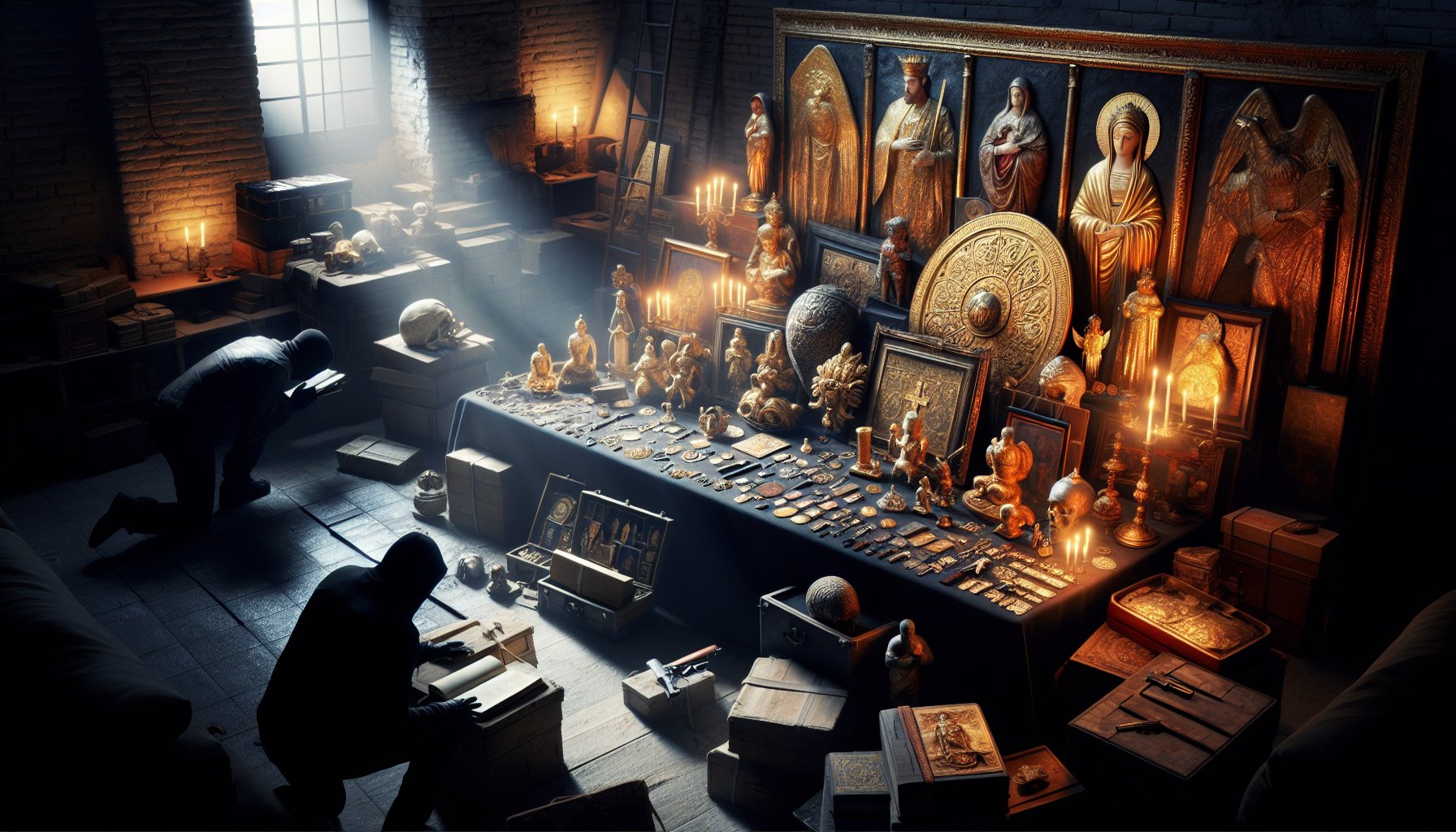In the shadowy recesses of our world, where ancient faith and modern commerce intersect, lies a clandestine network that thrives on secrecy and intrigue. This is the enigmatic realm of religious black markets—a place where sacred relics vanish from revered sanctuaries, only to resurface as prized possessions in the hands of the highest bidder. 🕵️♂️ As we journey into this hidden underworld, we unravel a tapestry of mystery and exploitation that spans continents and centuries. The allure of these artifacts, steeped in divine history and myth, transcends mere material value; they are symbols of faith, power, and identity. But what fuels this covert trade, and who are the players behind the scenes? More importantly, what measures are being taken to reclaim what has been lost to this dark market?
Our exploration begins with the storied past of religious artifacts, tracing their journey from sacred temples and churches to the clandestine auctions and private collections where they now reside. We will delve into the historical and cultural significance of these items, examining why they are so coveted and what they represent to different communities around the globe. From the Holy Grail to Buddhist relics, these treasures often carry narratives of miracles and divine intervention, making them irresistible to collectors and devout believers alike. Alongside the history, we will uncover the sophisticated operations of artifact trafficking networks, exploring how they navigate the legal and ethical boundaries in their quest for profit. We will shed light on the shadowy figures who orchestrate these trades and the sophisticated channels they employ to evade law enforcement.
As we venture deeper, our narrative will also spotlight the tireless efforts of those dedicated to combating this illicit trade. From international task forces to local communities, there is a global movement determined to restore these artifacts to their rightful places. We will examine the challenges they face, including legal loopholes and limited resources, and celebrate the successes they achieve against overwhelming odds. Furthermore, we will consider the role of technology in this modern-day quest, from advanced forensic techniques to the use of blockchain in tracking provenance. 📜 Throughout this journey, we aim to ignite a conversation about the ethical implications and responsibilities of preserving our shared cultural heritage. Join us as we uncover the secrets of the religious black markets and the relentless hunt for missing artifacts, in a story that is as much about human tenacity as it is about faith and morality.
Introduction to Religious Black Markets
The mysterious world of religious black markets presents a fascinating and complex landscape, where sacred artifacts vanish into shadowy networks and reappear in private collections far from their origins. This hidden underworld thrives on the clandestine trade of religious artifacts, often plundering archaeological sites and sacred spaces. The demand for such items is fueled by collectors who place great value on the historical and spiritual significance of these objects, creating a lucrative market that operates largely outside the law.
The intricate web of the black market involves various players, including looters, middlemen, and collectors. Looters often target sites rich in cultural and religious significance, exploiting gaps in security or the lack of local resources for protection. These items are then sold to middlemen who smuggle them across borders, often with the help of corrupt officials. Finally, they reach collectors who are willing to pay exorbitant prices for these rare and precious items, often ignoring or being unaware of their illicit origins.
The impacts of religious black markets are profound, affecting not only the preservation of cultural heritage but also the communities from which these artifacts originate. These communities often lose tangible connections to their history and identity, with sacred artifacts being removed from their natural context. Moreover, the illicit trade of these items can fund other criminal activities, including terrorism, further complicating efforts to address this issue. Understanding the dynamics of religious black markets is essential for developing effective strategies to combat this illicit trade and protect the world’s cultural heritage.
The Demand for Religious Artifacts
The demand for religious artifacts in the black market is driven by a variety of factors, each contributing to the allure of these objects. For some collectors, these items represent a tangible connection to the divine or historical events, offering a sense of spiritual fulfillment. Others view these artifacts as investments, appreciating their value over time as they become rarer and more sought after. The mystique surrounding these objects, often linked to their sacred origins, further enhances their desirability.
Collecting religious artifacts has been a pursuit for centuries, but the black market adds a layer of complexity to this passion. Unlike legitimate collections, where provenance and legality are thoroughly vetted, the black market operates in secrecy, with little regard for ethical considerations. This environment attracts collectors who are either complicit in or ignorant of the unlawful nature of their acquisitions. The anonymity of the market also allows individuals to bypass restrictions and obtain items that are otherwise inaccessible.
To combat this demand, it is crucial to raise awareness about the implications of purchasing artifacts from black markets. Educating potential buyers on the cultural and historical significance of these objects, as well as the legal repercussions of engaging in such transactions, can help deter the demand. By fostering a culture of respect for cultural heritage and promoting ethical collecting practices, it is possible to reduce the appeal of the black market and protect the integrity of religious artifacts.
The Role of Technology in Tracking and Recovering Artifacts
Technology has become a powerful tool in the fight against the illegal trade of religious artifacts. Advanced methods of tracking and recovering these items have emerged, offering new hope for preserving cultural heritage. One of the most significant advancements is the use of digital databases and imaging technologies, which allow for the cataloging and identification of artifacts on a global scale. These resources enable authorities to quickly recognize stolen items and alert the appropriate channels for recovery.
Blockchain technology is also making strides in ensuring the provenance and authenticity of artifacts. By creating immutable records of an item’s history, blockchain can provide a transparent and verifiable trail of ownership, reducing the likelihood of items being illicitly traded. This technology empowers legitimate collectors and museums to verify the legality of their acquisitions, thereby discouraging involvement in the black market.
The use of social media and online platforms has further enhanced efforts to track and recover stolen artifacts. Organizations and individuals dedicated to the preservation of cultural heritage can share information and mobilize communities around the world. These platforms also serve as a means to publicize cases of missing artifacts, garnering public support and increasing pressure on authorities to act. Watch this informative video for more insights on how technology aids in artifact recovery: The Hunt for Stolen Artifacts – National Geographic.
Legal and Ethical Considerations
Navigating the legal and ethical landscape of religious artifact trade is a challenging endeavor, with numerous considerations to address. International laws and agreements, such as the UNESCO Convention, aim to curb the illicit trafficking of cultural property, providing a framework for the protection and return of stolen artifacts. These laws establish guidelines for provenance and due diligence, encouraging nations to collaborate in the fight against black market activities.
Ethical considerations are equally important, as the acquisition and display of religious artifacts must respect the cultural and spiritual significance of these items. Museums and collectors have a responsibility to ensure that their collections are legally and ethically sourced, reflecting a commitment to cultural preservation rather than exploitation. This involves thorough research into the provenance of items, as well as a willingness to return artifacts to their rightful owners when appropriate.
The intersection of law and ethics presents unique challenges, as legal ownership does not always equate to ethical stewardship. In some cases, artifacts may have been legally acquired under outdated or unjust laws, prompting calls for restitution. Addressing these issues requires a nuanced understanding of the historical context and a willingness to engage in dialogue with affected communities. The table below compares key legal and ethical considerations:
| Legal Considerations | Ethical Considerations |
|---|---|
| Provenance verification | Cultural sensitivity |
| Compliance with international laws | Community engagement |
| Due diligence | Respect for spiritual significance |
Community Efforts and International Collaboration
Community involvement is a vital component in the preservation of religious artifacts and the fight against black market trade. Local communities are often the custodians of cultural heritage, possessing invaluable knowledge about the significance and history of artifacts. By empowering these communities to protect their cultural heritage, it is possible to create a more sustainable and effective approach to combating artifact theft.
International collaboration is equally important, as the illicit trade of religious artifacts is a global issue that transcends borders. Nations must work together to establish and enforce laws that prevent the illegal trafficking of cultural property. This includes sharing intelligence, coordinating law enforcement efforts, and facilitating the return of stolen artifacts to their countries of origin.
Organizations such as INTERPOL and UNESCO play a crucial role in fostering international cooperation and providing resources for the recovery and protection of cultural heritage. Their efforts are supported by a network of experts, including archaeologists, historians, and legal professionals, who contribute their expertise to identify and recover stolen artifacts. By building a global coalition dedicated to preserving cultural heritage, it is possible to mitigate the impact of religious black markets and safeguard the world’s shared history for future generations.
- Engage local communities in artifact protection efforts.
- Foster international cooperation and intelligence sharing.
- Support organizations dedicated to cultural heritage preservation.

Conclusion
As we draw this exploration of the hidden world of religious black markets and the relentless pursuit of missing artifacts to a close, it’s imperative to reflect on the multifaceted dimensions we’ve covered. This topic, laden with historical, cultural, and ethical considerations, invites us to scrutinize the clandestine networks that thrive beneath the veneer of legitimate society. From the theft and illicit trade of invaluable artifacts to the cultural and spiritual ramifications of these losses, the depth of this issue is profound and far-reaching.
Firstly, we delved into the historical context, establishing that the trade of religious artifacts is not merely a modern dilemma but a persistent issue that spans centuries. This historical overview is crucial in understanding the current landscape, as it highlights patterns and practices that continue to evolve yet remain rooted in age-old traditions of plunder and conquest. By examining case studies and documented instances of artifact theft throughout history, we underscore the recurring themes of greed and the desecration of cultural heritage.
In examining the mechanisms of the black market, we shed light on the clandestine operations that facilitate the trafficking of these sacred items. From the initial theft to the eventual sale on the global market, each step is shrouded in secrecy and complicity. This section revealed the complex networks of thieves, middlemen, and buyers who perpetuate this cycle of cultural vandalism. Understanding these mechanisms is vital for developing effective countermeasures and international policies aimed at curbing the illegal trade.
The ethical implications of the black market for religious artifacts cannot be overstated. The loss of these items often signifies more than just a material deficit; it represents a profound spiritual and cultural void for communities whose heritage is being systematically eroded. We explored the devastating impact on cultural identity and continuity, emphasizing the moral responsibility that falls on individuals and institutions to protect and preserve our shared human history.
Furthermore, we highlighted the role of technology and international cooperation in combating the illicit trade of artifacts. The use of databases, digital registries, and collaborative efforts between nations and organizations has proven pivotal in tracking and recovering stolen items. This cooperation not only aids in the retrieval of lost artifacts but also acts as a deterrent to potential traffickers.
The importance of public awareness and education in this fight cannot be ignored. By bringing attention to the issue, we empower individuals and communities to become stewards of cultural preservation. Through educational campaigns and public engagement, we can cultivate a global consciousness that values and protects cultural heritage.
As we conclude, it is clear that the battle against the black market for religious artifacts is ongoing and requires a multifaceted approach. The collaboration of governments, cultural institutions, and individuals is essential in safeguarding our global heritage. By working together, we can ensure that future generations inherit a world where cultural diversity and history are respected and cherished.
We encourage you, dear reader, to engage with this topic further. Share this article, discuss it with others, and consider how you can contribute to the preservation of cultural heritage. Whether through supporting relevant organizations, advocating for stronger protections, or simply spreading awareness, your involvement is invaluable.
For those interested in exploring more, I recommend visiting resources such as INTERPOL’s Works of Art database and UNESCO’s efforts in the fight against illicit trafficking. These platforms offer a wealth of information and tools to further understand and engage with this critical issue.
In conclusion, let us remain vigilant and proactive in the quest to uncover and protect the sacred relics of our past. Together, we can forge a future that honors and preserves the diverse tapestry of human history. 🌍✨
Toni Santos is a visual storyteller and symbolic artisan whose work unearths the sacred in forgotten places — a seeker of relics not cast in gold, but in petal, vine, and stone.
Through a reverent artistic lens, Toni explores nature as a vessel for unknown religious relics — sacred echoes embedded in botanical forms, remnants of spiritual traditions that were never written but always felt. His creations are not merely decorative; they are quiet devotions, fragments of invisible altars, living prayers suspended in time.
Guided by an intuitive connection to flora and the mysteries they carry, Toni transforms botanical elements into symbolic artifacts — each one a relic of forgotten faiths, imagined rituals, or ancient wisdom left behind by time. His work invites reflection on how the divine speaks through organic beauty, and how the sacred often hides in the overlooked.
As the creative voice behind Vizovex, Toni curates collections and visual meditations that feel like lost sacred texts — poetic, intentional, and charged with quiet meaning. From floral talismans to mythic botanical studies, his work bridges earth and spirit, nature and memory.
His work is a tribute to:
The invisible sanctity found in everyday natural forms.
The mythic energy of plants as spiritual messengers.
The act of creating relics from silence, shadow, and growth.
Whether you’re drawn to mysticism, symbolic art, or the sacredness woven into the natural world, Toni invites you to explore a space where forgotten relics are remembered — one leaf, one symbol, one sacred fragment at a time.




